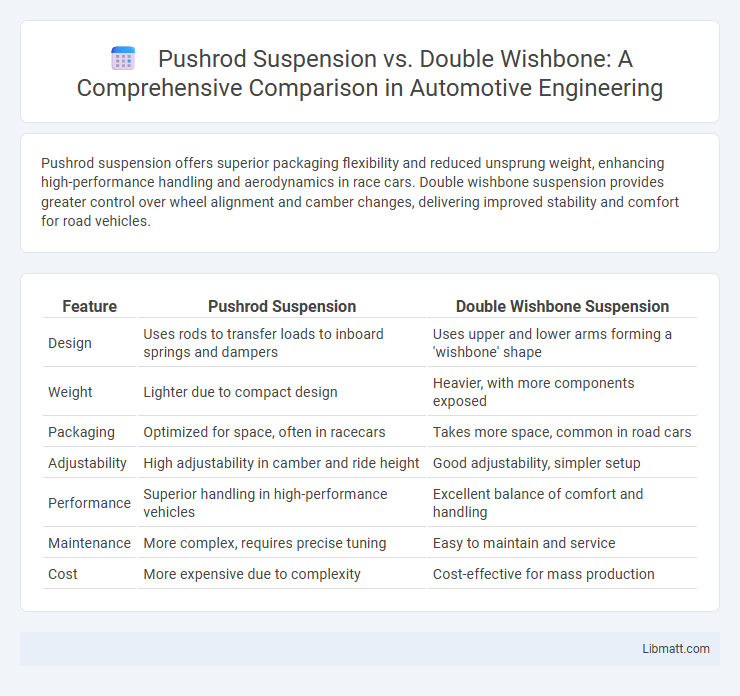Pushrod suspension offers superior packaging flexibility and reduced unsprung weight, enhancing high-performance handling and aerodynamics in race cars. Double wishbone suspension provides greater control over wheel alignment and camber changes, delivering improved stability and comfort for road vehicles.
Table of Comparison
| Feature | Pushrod Suspension | Double Wishbone Suspension |
|---|---|---|
| Design | Uses rods to transfer loads to inboard springs and dampers | Uses upper and lower arms forming a 'wishbone' shape |
| Weight | Lighter due to compact design | Heavier, with more components exposed |
| Packaging | Optimized for space, often in racecars | Takes more space, common in road cars |
| Adjustability | High adjustability in camber and ride height | Good adjustability, simpler setup |
| Performance | Superior handling in high-performance vehicles | Excellent balance of comfort and handling |
| Maintenance | More complex, requires precise tuning | Easy to maintain and service |
| Cost | More expensive due to complexity | Cost-effective for mass production |
Introduction to Suspension Systems
Pushrod suspension features a system where the wheel motion is transferred via a pushrod to inboard-mounted springs and dampers, reducing unsprung mass and improving aerodynamics. Double wishbone suspension relies on two control arms that maintain precise wheel alignment and offer superior handling and ride quality through better camber control. Both systems play critical roles in vehicle dynamics, with pushrod setups favored in high-performance applications and double wishbone widely used for balanced performance and durability.
Overview of Pushrod Suspension
Pushrod suspension uses a system where the wheel's vertical movement is transferred through a pushrod to an inboard-mounted spring and damper, optimizing weight distribution and aerodynamics. Commonly found in high-performance and Formula 1 cars, it allows precise suspension tuning and reduces unsprung mass compared to traditional setups. This design enhances handling response and stability, especially at high speeds and under dynamic cornering conditions.
Overview of Double Wishbone Suspension
Double wishbone suspension features two control arms per wheel, providing precise handling and superior camber control compared to pushrod setups. This design enhances tire contact with the road, improving grip and stability during cornering. You benefit from better suspension geometry adjustments, resulting in improved performance and ride comfort.
Key Differences Between Pushrod and Double Wishbone
Pushrod suspension systems use a pushrod connected to the wheel hub that transfers forces to inboard-mounted springs and dampers, optimizing aerodynamics and reducing unsprung weight. Double wishbone suspension features two control arms (upper and lower) allowing precise control over camber, caster, and toe angles, enhancing handling and stability. Your choice depends on performance needs: pushrod excels in high-speed racing due to aerodynamic benefits, while double wishbone offers superior adjustability and comfort for varied driving conditions.
Performance Implications in Motorsports
Pushrod suspension systems offer superior aerodynamic advantages and precise wheel control, making them ideal for high-speed motorsport applications where minimizing unsprung mass and maximizing downforce are critical. Double wishbone suspensions provide excellent mechanical grip and straightforward tuning capabilities, allowing for better feedback and adaptability on varied track conditions. The choice between pushrod and double wishbone setups directly impacts handling responsiveness, cornering stability, and overall vehicle dynamics in competitive racing environments.
Ride Comfort and Handling Characteristics
Pushrod suspension offers superior handling characteristics by allowing more precise tuning and reducing unsprung weight, enhancing your vehicle's responsiveness and cornering stability. Double wishbone suspension provides excellent ride comfort due to its ability to maintain optimal tire contact and absorb road irregularities effectively. Both systems improve performance, but pushrod excels in high-performance handling while double wishbone prioritizes balanced comfort and control.
Cost and Complexity of Each System
Pushrod suspension systems typically incur higher costs due to specialized components and precise engineering requirements, increasing manufacturing complexity and maintenance expenses. Double wishbone setups offer a more straightforward design with lower production costs and simpler maintenance, making them more accessible for mass-market vehicles. The intricate geometry of pushrod systems improves performance but demands skilled labor and expensive materials, contrasting with the relatively affordable and robust double wishbone architecture.
Suitability for Road and Track Applications
Pushrod suspension offers superior handling and adjustability, making it highly suitable for track applications where precise tuning and reduced unsprung weight are critical. Double wishbone suspension provides excellent ride comfort and stability, ideal for road use as it balances performance with daily driving comfort. Your choice depends on whether you prioritize track-focused performance or versatile, comfortable road handling.
Maintenance and Durability Considerations
Pushrod suspension systems typically require more specialized maintenance due to their complex design and precise adjustment needs, often found in high-performance vehicles. Double wishbone suspensions are generally more durable and easier to service, with widely available components and straightforward inspection processes, making them suitable for everyday use. Understanding your vehicle's suspension system helps you anticipate maintenance demands and ensures optimal durability for your driving conditions.
Which Suspension System is Right for You?
Choosing between pushrod suspension and double wishbone depends on your vehicle's performance needs and driving style. Pushrod suspension offers improved aerodynamics and better weight distribution, ideal for high-speed racing applications, while double wishbone provides superior handling and ride comfort suitable for everyday driving and spirited street use. Your decision should consider factors like track conditions, maintenance complexity, and how much you prioritize precise control versus ease of tuning.
pushrod suspension vs double wishbone Infographic

 libmatt.com
libmatt.com